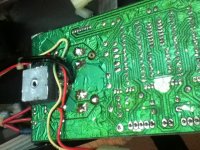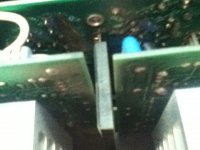the electrolyte from your blown cap should easily clean up with mild soap(read dish detergent)and water and i'm not suggesting dropping the board in the sink with the china; a wipe with a dampened cloth or paper towel and a used toothbrush to lightly scrub in the tight spots followed by a good non residue contact cleaner ought to do it.
the electrolyte from your blown cap should easily clean up with mild soap(read dish detergent)and water and i'm not suggesting dropping the board in the sink with the china; a wipe with a dampened cloth or paper towel and a used toothbrush to lightly scrub in the tight spots followed by a good non residue contact cleaner ought to do it.
Well that sounds good except for 2 things.
1. I don't have any contact cleaner so I'll just skip that part.
2. I'm sort of wondering if the water will be a huge issue considering the condition of the pcb's (with the solder mask flaking off).
well without seeing what your talking about it's a little hard to say i would expect to see more contamination on the component side of the board if the crap is across traces that have become exposed because the solder mask is lifting it could be an issue but again i'm not suggesting flushing the board under running water getting the electrolyte crap off is going to require some elbow grease.
well without seeing what your talking about it's a little hard to say i would expect to see more contamination on the component side of the board if the crap is across traces that have become exposed because the solder mask is lifting it could be an issue but again i'm not suggesting flushing the board under running water getting the electrolyte crap off is going to require some elbow grease.
I'll get you a pic in a sec.
EDIT: Upon closer inspection of these pcb's I found something WEIRD. Rember I said the solder mask seems all "bubbled" up? Well I decided to scrape off a bit of some of the solder mask and it appears that under most of these bubbles is actually not air, but the traces themselves. Its as if when they made these pcb's they somehow messed them up real bad. Its the surface of the actual traces underneath the solder mask that is all bumpy and enlarged. Only a few of these solder mask bubbles are empty, and the traces flat.
Last edited:
Here's the pics.
First pic shows the underside of the power supply board. You can see all the bubbly solder mask, which actually is (like I said) not air under it as I previously thought, its actually just a deformation in the traces from its manufacture I suppose.
In the second picture you see the back of the output module, it has solder mask bubbles that are actually full of air, and will flake off if you touch them (you can see shiny spots where this has happened).
I guess the best way to describe it is that for most of the powersupply board's underside, the actual metal traces themselves are deformed, thus the solder mask on top of them, though still mostly adhered, is deformed.
First pic shows the underside of the power supply board. You can see all the bubbly solder mask, which actually is (like I said) not air under it as I previously thought, its actually just a deformation in the traces from its manufacture I suppose.
In the second picture you see the back of the output module, it has solder mask bubbles that are actually full of air, and will flake off if you touch them (you can see shiny spots where this has happened).
I guess the best way to describe it is that for most of the powersupply board's underside, the actual metal traces themselves are deformed, thus the solder mask on top of them, though still mostly adhered, is deformed.
Attachments
so where's the electrolyte contamination i don't see it
That's just a clear liquid on the topside of the board. I didn't think I needed pics of it, do I?
Well I couldn't stand just standing here any longer. I took a bit of soap, some hot water, and a sponge and in about 5 minutes that power supply board looked cleaner than before the cap even blew up 😀
But first I need to find out how to clean up the electrolyte from the blown cap....(any help???).
Looks like I'm too late, but this is still worth mentioning. As an electronics hobbyiest, this should become your best friend: CRC 05101 QD Electronic Cleaner - 4.5 Wt Oz. : Amazon.com : Automotive
You can find it cheaper at a local hardware store. At least, you can here.
Use it for cleaning speaker contacts and terminals too!
Looks like I'm too late, but this is still worth mentioning. As an electronics hobbyiest, this should become your best friend: CRC 05101 QD Electronic Cleaner - 4.5 Wt Oz. : Amazon.com : Automotive
You can find it cheaper at a local hardware store. At least, you can here.
Use it for cleaning speaker contacts and terminals too!
I did use that stuff for a while but I was thinking of switching over to Deoxit.
I would be hesitant to use a chemical that left a residue behind on electronics. That residue is conductive in this case, so shorting on circuit PCB may be possible. Did you come to dislike the QD cleaner? Why switch?
I would be hesitant to use a chemical that left a residue behind on electronics. That residue is conductive in this case, so shorting on circuit PCB may be possible. Did you come to dislike the QD cleaner? Why switch?
I didn't use a chemical that left a residue, unless your talking about deoxit, which I thought versions of that didnt leave a residue?
I only got into electronics in the past few years, after I was already interested in electrical for years, and I had a few cans of QD but they ran out like a year ago, after looking around on the internet, I thought next time I buy some elctronics cleaner, I'd buy Deoxit. Otherwise the QD stuff always worked well for me.
Well I'm surprised they can justify using even 67V, as I calculated the rectified dc should be 70V.
Either way, I'm going with 100V 10,000uf caps 😀 Because I can find them on eBay for almost half mouser's price.
eBay is an excellent place to get counterfeit exploding electrolytics, particularly if they are a lot cheaper than they should be - it has happened to more than one member here, and I have seen counterfeit caps first hand. Spend the extra money and get them from Mouser or Digikey..
Here's the pics.
First pic shows the underside of the power supply board. You can see all the bubbly solder mask, which actually is (like I said) not air under it as I previously thought, its actually just a deformation in the traces from its manufacture I suppose.
In the second picture you see the back of the output module, it has solder mask bubbles that are actually full of air, and will flake off if you touch them (you can see shiny spots where this has happened).
I guess the best way to describe it is that for most of the powersupply board's underside, the actual metal traces themselves are deformed, thus the solder mask on top of them, though still mostly adhered, is deformed.
It's not deformed and is quite deliberate, this was a way of somewhat beefing up the conductor surface area to avoid the need for heavy copper traces. Not uncommon in higher powered amps. I worked for a large audio manufacturer that used this technique on its pcbs - much cheaper than the 2 - 4oz copper they should have been using. (If done correctly there should be a lot of solder on those traces, with age the solder mask sometimes starts to flake off, this should not be a problem if the trace was fully tinned.)
I generally use 91% isopropyl alcohol from the local pharmacy for cleaning my pc boards... Water and mild dish detergent is good for some types of dirt/grease that alcohol doesn't handle well.
Indeed, the QD is essentially alcohol in a spray can, or so I have been told. The point of it is to clean and then evaporate extremely quickly, leaving nothing behind.
There is a two part CPU cleaner kit sold which is basically goo gone for the first part and isopropyl alcohol for the second part, but with a huge markup in price.
Deoxit's website said it was a cleaner and lubricant! Scary. I don't think it's use would be appropriate in this application.
There is a two part CPU cleaner kit sold which is basically goo gone for the first part and isopropyl alcohol for the second part, but with a huge markup in price.
Deoxit's website said it was a cleaner and lubricant! Scary. I don't think it's use would be appropriate in this application.
- Status
- Not open for further replies.
- Home
- Amplifiers
- Solid State
- Crest Audio LA601 Repair Help

